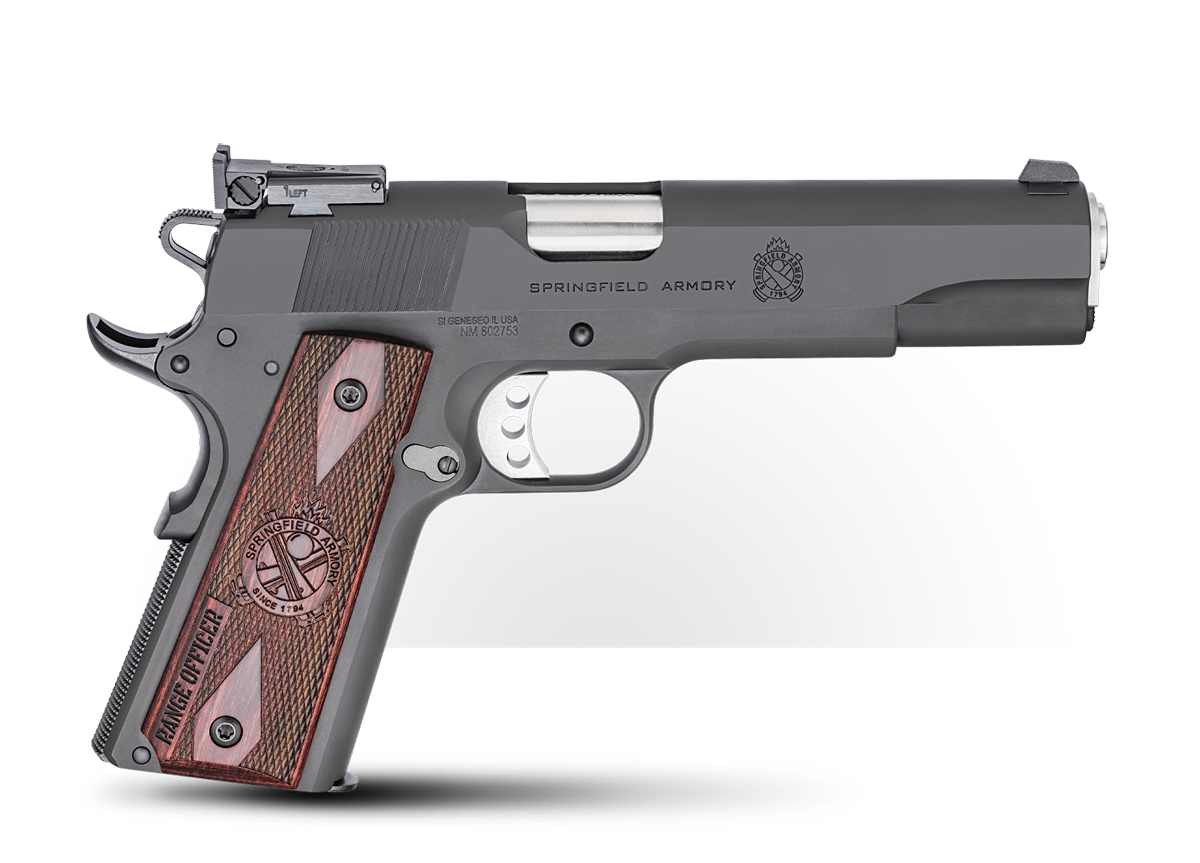Springfield Armory Range Officers
April 4th, 2020
10 minute read
Springfield Armory is one of the top producers of semi-automatics on the 1911 pattern, and the arrival of the Range Officer was greeted enthusiastically. This is a full-sized 1911, blued steel, chambered in .45 ACP and basically an upgraded Mil-Spec. The frame is forged as is the slide, with both being precision hand-fitted. Both the barrel and bushing are stainless steel and the barrel is of national match quality. This Target Model’s sights are black the way they should be for easy visibility, consisting of a square notch rear sight matched up with a sloping post front sight. The front sight is set in a dovetail allowing for easy windage adjustment or even replacement if desired. The rear sight is also in a dovetail, set very low into the slide and is adjustable for both windage and elevation.
Slide to frame fit is just about perfect. The extended trigger is light-weight aluminum with three holes drilled in it and serrations on the front, while the hammer is lightweight and skeletonized. The trigger pull measures 5 3/4 pounds on my test gun. The grip safety is of the beavertail style with a memory bump and cut-out on top for the hammer. The mainspring housing is original 1911 flat-style and is checkered, while the front strap is smooth. The whole package is reminiscent of customized military .45s from the middle of the 20th century.
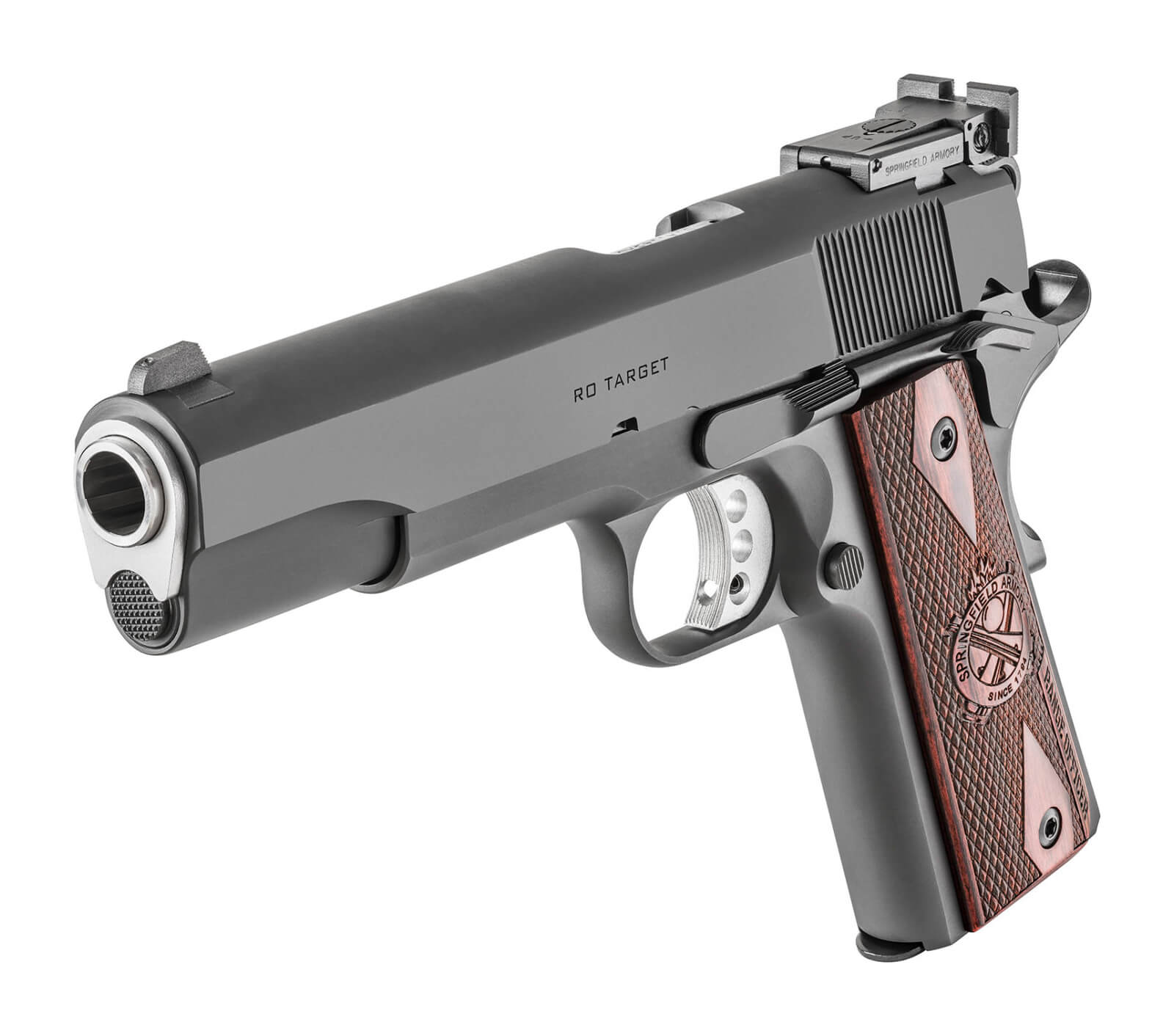
Springfield Armory advertised their new Range Officer as being suitable for competition without any unneeded extras. It certainly makes a fine self-defense pistol also as it has the most desired attributes in upgrading a 1911, with excellent sights, extended thumb safety and beavertail grip safety. The magazine release also works very easily and positively. Two things I really appreciate, again this is definitely subjective on my part, is the fact it does not have an ambidextrous safety and the magazine is the old traditional flat bottom style without that funny looking pad on the bottom.
I can understand why some competition shooters want the pad but my competition days are long gone and I will choose form over function in this case. In the case of the ambidextrous safety if I ever do have to shoot left-handed I do not find it a great disadvantage to have to push the safety off with my left hand.
Shooting the Range Officer proves to be pure pleasure. Outstanding results include the Black Hills 230 grainers; their standard 230-gr. JHP clocks out at 770 fps and puts five shots in 7/8″ while the FMJ version duplicates the muzzle velocity and cuts the group size to 5/8″. What really intrigues me is the fact the Black Hills 230-gr. round-nosed lead rounds group at just over 1″. Winchesters are very consistent, with the 185-gr. SilverTip, 230 JHP and 230 FMJ all grouping in 1 1/4″. This pistol — and other Range Officers we’ve tested — all shoot like custom match 1911s!
There are many lightweight pocket pistols available today, including some made by Springfield Armory, however the original full-sized 1911 is still easy to pack, easy to conceal, and fast into service. In this case packing around a little extra weight is a very comforting feeling. There seems to be no end to the customizing which can be accomplished, but for a 1911 with everything needed and nothing that isn’t, it would be hard to find anything better than the Springfield Armory Range Officer. It’s one of my top nominees as a Perfect Packin’ Pistol, Semi-Auto style.
Upgrades
Now Springfield Armory has moved the Range Officer up a notch in the competition for PPP by bringing out the same excellent pistol in stainless steel. Everything said so far about the Range Officer applies to this newest offering with the addition of being constructed entirely of weather-beating stainless steel. The original Range Officer with its Parkerized finish is a very business looking .45. The Stainless Steel Model is every bit as serious looking and is also an extremely attractive pistol. I would have a hard time deciding which Range Officer to pick so as I always do in these types of situation — I simply bought ’em both!
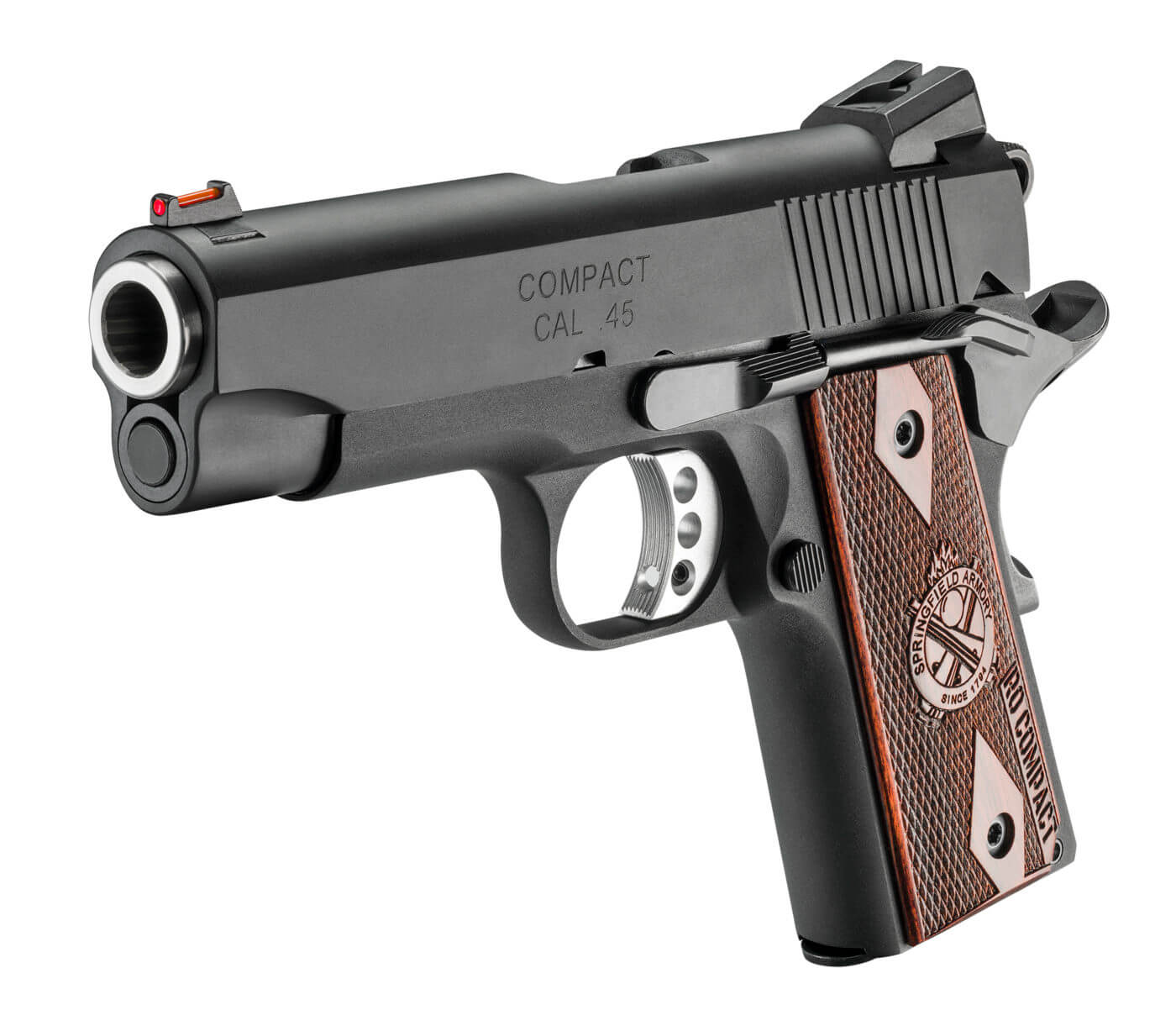
When it comes to firearms, downsizing can be a very good thing and that is exactly what has happened at Springfield Armory. No, the company has not downsized, but they have downsized their popular Range Officer in a very positive way, resulting in the Range Officer Compact.
Springfield Armory has said of the Compact Range Officers: “If you want a competition grade 1911 that conceals better than a full-sized pistol, the Range Officer Compact from Springfield Armory offers finely tuned performance in a smaller package. The Range Officer Compact brings the precision of the competition pistol in a small and straightforward configuration.”
The Range Officer Compact Model is not simply a Range Officer which has been shrunk. A few changes have been made, some of which are external, while others are internal. The first things noticed are probably the shorter barrel, which is now 4″, and the Officer’s Model-sized grip frame. The magazine holds six rounds, making it 7-round capacity pistol. Sights are also different. Instead of the fully adjustable competition styled sights found on the full-sized Range Officer, the Compact Model has more typical self-defense sights with a low profile “combat” rear sight in a dovetail while the front sight, also in a dovetail, is a red fiber optic sight. The square notch of the rear sight has a white dot on each side so these sights pick up very quickly even in low light.
One of the main differences is the fact the Compact Model has a full-length guide rod instead of a bushing; even though there is no bushing, the barrel of the Compact Model is tapered at the muzzle end for a tighter fit in the slide. The barrel is a national match stainless steel barrel and the national match frame and slide are of the same material and precision as those found in their Trophy Match 1911s. The beavertail grip safety has a memory bump, the flat mainspring housing is checkered, and the trigger is an extended lightweight style. Trigger pull is smooth and creep-free and seemed lighter than the measured 4 3/4 pounds. The thumb safety on the left side is striated for a positive operation. The magazine release is the standard on the left side style and operates very positively.
Lighter Is Good
Normally the first thing I do with any sixgun or semi-auto is check the quality, size and fit of the grip panels which normally results in my changing them. The grip panels on the Compact Model are entirely satisfactory. They are slim and fit well and are of the double diamond checkered variety and appear to be of rosewood. Each panel has the Springfield Armory logo in the center and the words “RO COMPACT” along the bottom back side of each panel.
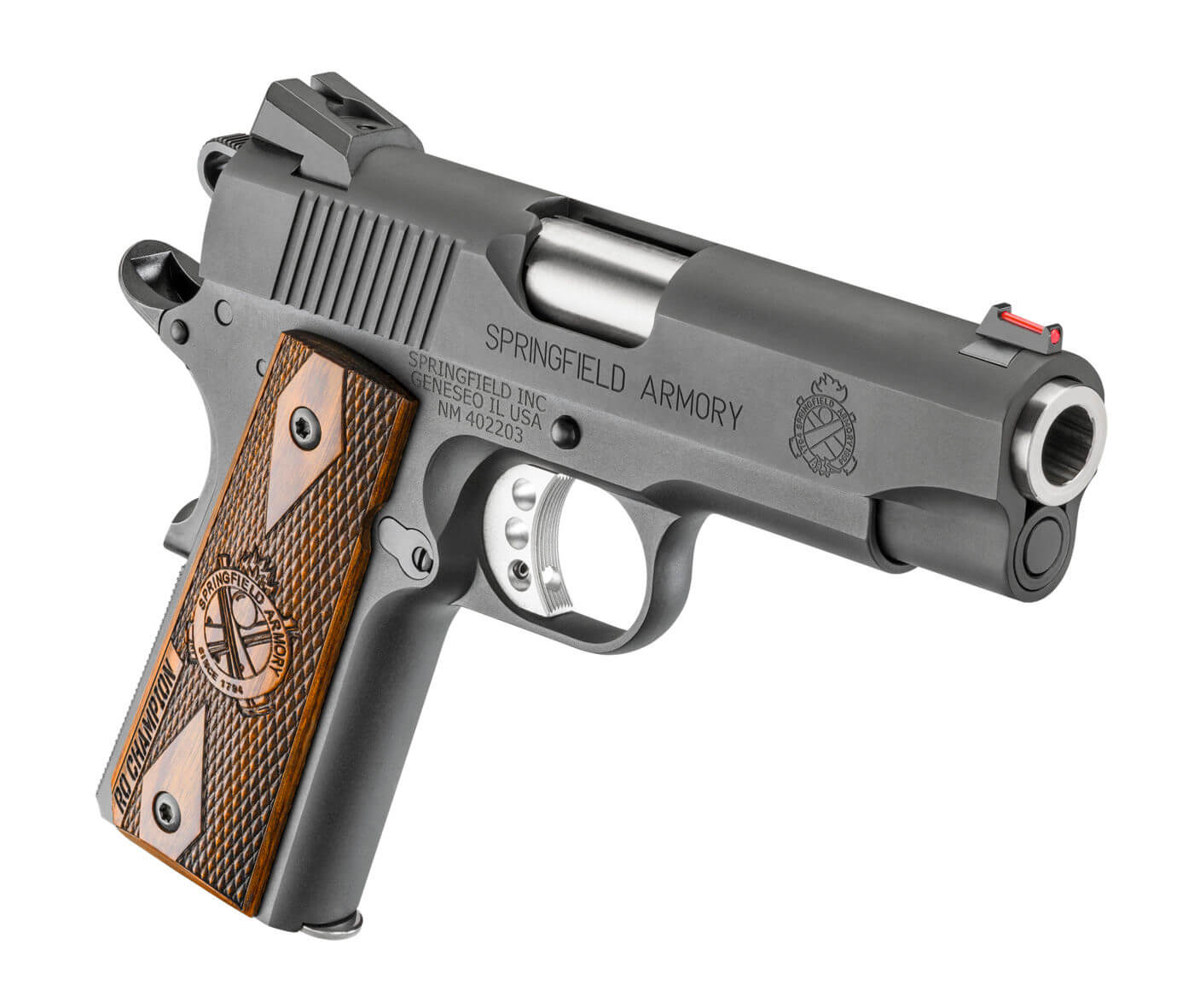
These desirable little pistols come in an exceptionally sturdy, lockable padded case which not only holds the pistol in a padded cut-out but also an extra magazine, a bristle brush, a Springfield Armory polymer holster and a polymer double magazine pouch. Each Compact Model comes with two magazines — so if the pouch is going to be used, an extra magazine, or more, should be ordered from Springfield Armory. Also included in the case is a refill for the fiber optic front sight.
So Springfield Armory has these two exceptional .45 ACP Range Officers and a Compact version, so what could they possibly do as the next step? The logical choice was the same thing done to the original 1911 .45 ACP back in 1950 — bring out a lightweight, easier to pack version.
So the 5″ all-steel .45 ACP Range Officer has now been joined by an alloy-framed, 4″ barreled carry pistol in the Commander-style Lightweight Champion. In addition to the change in barrel lengths and frame material, cutting 25 percent off of the original 40 ounce weight — the Champion employs a guide rod and tapered barrel rather than the standard barrel and bushing set up of the full-sized Range Officer. The sights have also been changed from adjustable to tactical-style with a fiber-optic front sight matched up with a low profile combat rear sight.
To lessen wear on the alloy frame, the Champion has a fully supported ramped hammer forged barrel. Just as with the original Range Officer, the Champion as a full beavertail grip safety and flat mainspring housing. The sights, the flat mainspring housing, and the beavertail grip safety are all improvements over the original 1950 design making this Lightweight .45 much easier to shoot.
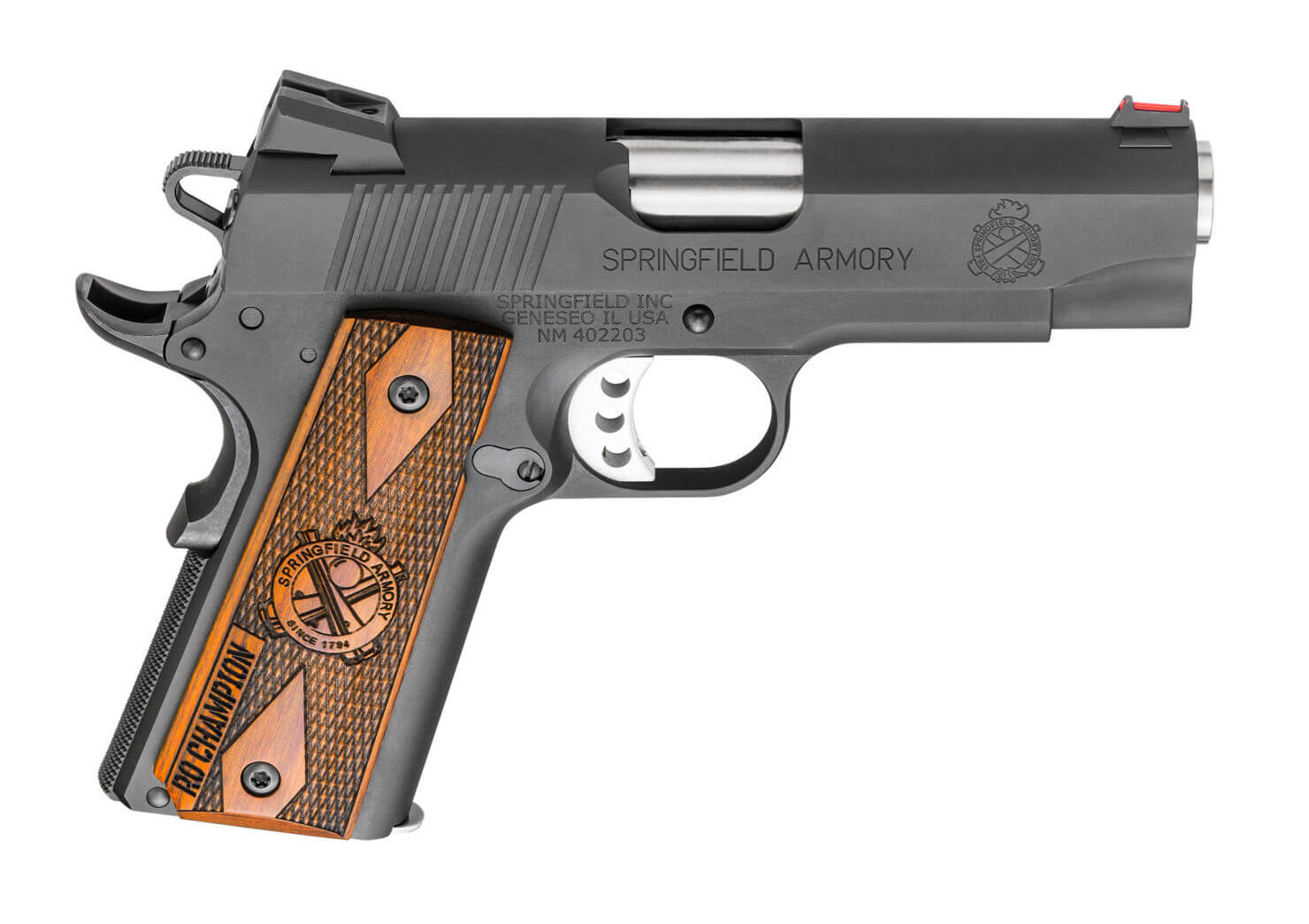
Easy Carrying
The standard-sized, all-steel 1911 is much easier to carry all day than a comparable sized sixgun due to its flat profile. But even the 1911, which gives a very comforting feeling, can become quite heavy in a long day’s carry. The Commander-sized, alloy-framed Champion not only gives a comforting feeling, it can also feel a lot more comfortable at the end of the day. Lightweight Commanders have not been easy to find in recent years and the Springfield Armory Champion is a welcome addition.
Basically the Champion Lightweight is a Compact Model with a full-sized grip frame; or we could say the Compact Model is a Champion Lightweight with a shortened butt. Everything we have said about the Compact Model applies to the Champion Lightweight. Or we could say the Springfield Armory Range Officer Compact Pistol is basically an Officer’s Model with a Commander slide and barrel. This means we have 1″ less barrel and distance between sights than the standard Range Officer and a much smaller grip to hold onto. For me at least both of these have an effect on the results; however, I definitely received pleasant surprises. Test-firing the .45 ACP version at 20 yards I was surprised at how well I could shoot this little pistol with such a short grip frame. Nine loads were used and with a .45 ACP this small, at least in my hands, firing hundreds of rounds is not what I would call fun. However this is overshadowed by the excellent results obtained.
With the .45 ACP Compact, my best factory loads were HPR 185 JHPs at 903 fps and their 230 JHP at 811 fps, with both placing five shots at 20 yards in a group of 1 3/8″. The Black Hills 185 JHP, 909 fps, and Remington’s 230 MC, 785 fps, both placed their five shots in 1 3/4″ at the same distance. Liberty Civil Defense offers a 78 grain load with a hollowpoint which looks to be bigger than the national debt, clocks out at an amazing 1,855 fps, and still manages to place all five shots in 1 1/2″ and very close to point of aim.
Switching to reloads this was my first chance to try Hi-Tek Coated bullets from Acme Bullets. These reloads are very easy to spot as the bullets are coated in bright red and in a brass case they look like lipstick. They not only look good they shoot well and the 230 grain round nose over 8.5 grains of Blue Dot is just under 800 fps with five shots in 1 1/2″. The most accurate load I came onto was a reload using the Hornady 230 XTP over 6.3 grains of Hodgdon’s CFEPistol powder for a very pleasant shooting 770 fps with five shots going into what I consider an amazing — from my hands — 1″ at 20 yards.
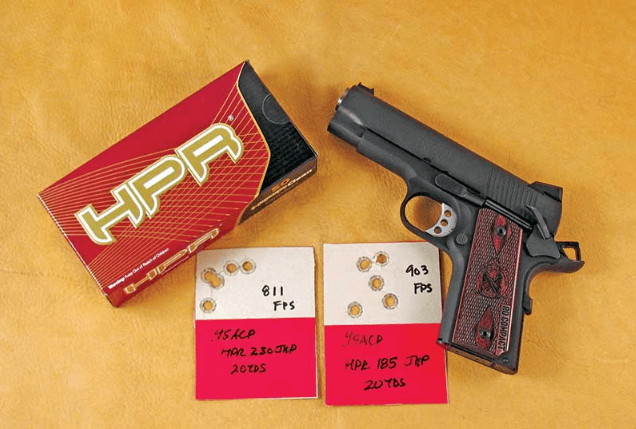
More Shooting
The Range Officer .45 stainless steel and the .45 Lightweight Champion both arrived around Christmas time and while we all may look forward to a white Christmas, winter is not the best time for me to be shooting outdoors. Moving indoors, I find the temperature much more pleasant. However it is difficult for me to see the sights as well without natural lighting. Nevertheless, I did get some excellent groups.
With the full-sized stainless steel Range Officer, my easy shooting loads of the Oregon Trail 200 SWC and 200 RNFP loaded over 4.0 grains of Bullseye both clocked right at 750 fps with groups just over 1″. I got the same results with the Acme Hi-Tek coated 200 grain SWC over 9.0 grains of Blue Dot with a muzzle velocity of 921 fps. My best group was obtained with the Hornady 230 XTP-HP over 6.3 grains of CFEPistol for right at 800 fps and a 1″ group. The Commander-sized Champion really liked the Oregon Trail 200 RNFP load clocking out at just over 750 fps and grouping into 1″. However, this little pistol has a very strong recoil spring and while it would shoot these loads very well it would not extract them completely. So the answer for this Champion if I want to use these very pleasant shooting loads, and I do, is to replace the factory spring with a lighter spring.
For my use there is no doubt the full-sized Range Officer is much easier to shoot, and especially in the case of the .45 ACP, much more pleasant to shoot. However, while the Range Officer is designed basically for competition and as an everyday working gun, the Range Officer Compact Model is much easier to conceal. In a proper holster it probably doesn’t make any difference whether the barrel length is 4″ or 5″, however it can make a difference if one is using an outside the pants holster covered by a vest. In this case 1″ of the barrel can make a significant difference.
Versatility
The greater advantage of the Compact Model is the shorter grip frame which makes it easier to conceal under a jacket with less chance of the butt printing. I’ll continue to use the Range Officer .45 ACP for most shooting duties (I’m way past the age for organized competition!), grab the Champion when I want a lighter weight .45 with a full-size grip frame, and reach for the Compact Models when I want to slip a totally reliable semi-auto pistol in my waistband. They also carry very easily and securely in the Springfield Armory supplied polymer holsters. Springfield Armory has once again come up with an excellent pistol.
You might think with all of these .45 variations Springfield Armory would be content just to sit back. Not so! In addition to the Parkerized and stainless steel Range Officers, Springfield is also now offering a rail model for easy use of a laser or flashlight. One added benefit I have found with rail models is they seem to shoot a little bit more accurately than standard models; might be the stiffness the rail gives to the frame. And an extra added bonus is the fact every model mentioned in .45 ACP is also available in the lighter recoiling, less expensive to shoot 9mm. The choice is ours.
Editor’s Note: This article was written by John Taffin and shared with us by American Handgunner. The original article can be seen here. Also, be sure to check out The Armory Life Forum, where you can comment about our daily articles, as well as just talk guns and gear. Click the “Go To Forum Thread” link below to jump in!
Join the Discussion
Featured in this article
Continue Reading
Did you enjoy this article?

 75
75




